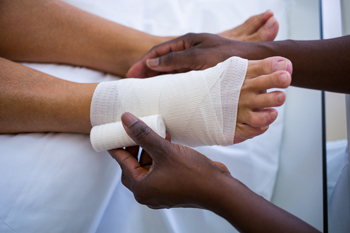
Many people have endured injuries that leave wounds, and this can often affect the feet. Practicing good wound care techniques is essential in having the wound heal properly. Many wounds require the dressing to be changed several times per week, and it is helpful to follow specific procedures to ensure that this is properly done. It can begin with having a bag close by in which the old dressing and gloves can be disposed of. The wound is then cleaned by washing it with lukewarm water. This is followed by applying the new dressing, and making sure it completely covers the wound. If the wound emits an odor, or if the skin surrounding it becomes red and heated, it is suggested that you consult with a podiatrist who can guide you on correct wound care treatment.
Wound care is an important part in dealing with diabetes. If you have diabetes and a foot wound or would like more information about wound care for diabetics, consult with Howard Waxman, DPM from Pleasant Valley Podiatry. Our doctor will assess your condition and provide you with quality foot and ankle treatment.
What Is Wound Care?
Wound care is the practice of taking proper care of a wound. This can range from the smallest to the largest of wounds. While everyone can benefit from proper wound care, it is much more important for diabetics. Diabetics often suffer from poor blood circulation which causes wounds to heal much slower than they would in a non-diabetic.
What Is the Importance of Wound Care?
While it may not seem apparent with small ulcers on the foot, for diabetics, any size ulcer can become infected. Diabetics often also suffer from neuropathy, or nerve loss. This means they might not even feel when they have an ulcer on their foot. If the wound becomes severely infected, amputation may be necessary. Therefore, it is of the upmost importance to properly care for any and all foot wounds.
How to Care for Wounds
The best way to care for foot wounds is to prevent them. For diabetics, this means daily inspections of the feet for any signs of abnormalities or ulcers. It is also recommended to see a podiatrist several times a year for a foot inspection. If you do have an ulcer, run the wound under water to clear dirt from the wound; then apply antibiotic ointment to the wound and cover with a bandage. Bandages should be changed daily and keeping pressure off the wound is smart. It is advised to see a podiatrist, who can keep an eye on it.
If you have any questions, please feel free to contact one of our offices located in Willoughby Hills and Broadview Heights, OH . We offer the newest diagnostic and treatment technologies for all your foot care needs.

Athlete’s foot can be extremely uncomfortable. It is a foot condition that is caused by a fungal infection of the skin, and generally affects the toes and soles of the feet. The fungus that causes this condition lives in warm and moist environments, such as shower room floors and public swimming pools. Because the fungus is contagious, it is beneficial to wear appropriate shoes while in these types of areas. Additionally, it is wise to refrain from sharing shoes, towels, and socks, as this may help to limit the spread of athlete’s foot. Research has indicated there are two types of athlete’s foot fungus. Trichophyton rubrum is classified as long-lasting and may often be recurring. Trichophyton mentagrophytes is a type of fungus that is found between the toes and is treatable, despite its severity. If you have itchy skin on your feet, it is suggested that you confer with a podiatrist who can properly diagnose and treat athlete’s foot.
Athlete’s foot is an inconvenient condition that can be easily reduced with the proper treatment. If you have any concerns about your feet and ankles, contact Howard Waxman, DPM from Pleasant Valley Podiatry. Our doctor will treat your foot and ankle needs.
Athlete’s Foot: The Sole Story
Athlete's foot, also known as tinea pedis, can be an extremely contagious foot infection. It is commonly contracted in public changing areas and bathrooms, dormitory style living quarters, around locker rooms and public swimming pools, or anywhere your feet often come into contact with other people.
Solutions to Combat Athlete’s Foot
Athlete’s foot can cause many irritating symptoms such as dry and flaking skin, itching, and redness. Some more severe symptoms can include bleeding and cracked skin, intense itching and burning, and even pain when walking. In the worst cases, Athlete’s foot can cause blistering as well. Speak to your podiatrist for a better understanding of the different causes of Athlete’s foot, as well as help in determining which treatment options are best for you.
If you have any questions please feel free to contact one of our offices located in Willoughby Hills and Broadview Heights, OH . We offer the newest diagnostic and treatment technologies for all your foot and ankle needs.
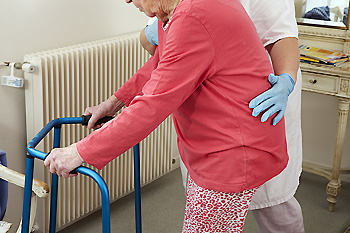
Sometimes when a senior citizen suffers a fall, it can be due to diminished strength in the feet. The fall can, in turn, further negatively affect the health of the senior’s feet. Many falls commonly take place in outdoor spaces. There are several things that a senior citizen might consider implementing to prevent falls from taking place in outdoor spaces. For example, a senior can ensure that their front steps or steps to a patio are even and not broken or loose. Additionally, a senior can be sure to turn on outdoor lighting fixtures after dark when going on the porch or patio to increase visibility. Lastly, during the winter, a senior might even consider using ice melt products in certain outdoor areas to combat slippery ice. If you are a senior citizen, or are caring for one, it is highly recommended that you reach out to a podiatrist for an appointment to learn more about fall prevention.
Preventing falls among the elderly is very important. If you are older and have fallen or fear that you are prone to falling, consult with Howard Waxman, DPM from Pleasant Valley Podiatry. Our doctor will assess your condition and provide you with quality advice and care.
Every 11 seconds, an elderly American is being treated in an emergency room for a fall related injury. Falls are the leading cause of head and hip injuries for those 65 and older. Due to decreases in strength, balance, senses, and lack of awareness, elderly persons are very susceptible to falling. Thankfully, there are a number of things older persons can do to prevent falls.
How to Prevent Falls
Some effective methods that older persons can do to prevent falls include:
Falling can be a traumatic and embarrassing experience for elderly persons; this can make them less willing to leave the house, and less willing to talk to someone about their fears of falling. Doing such things, however, will increase the likelihood of tripping or losing one’s balance. Knowing the causes of falling and how to prevent them is the best way to mitigate the risk of serious injury.
If you have any questions, please feel free to contact one of our offices located in Willoughby Hills and Broadview Heights, OH . We offer the newest diagnostic and treatment technologies for all your foot care needs.
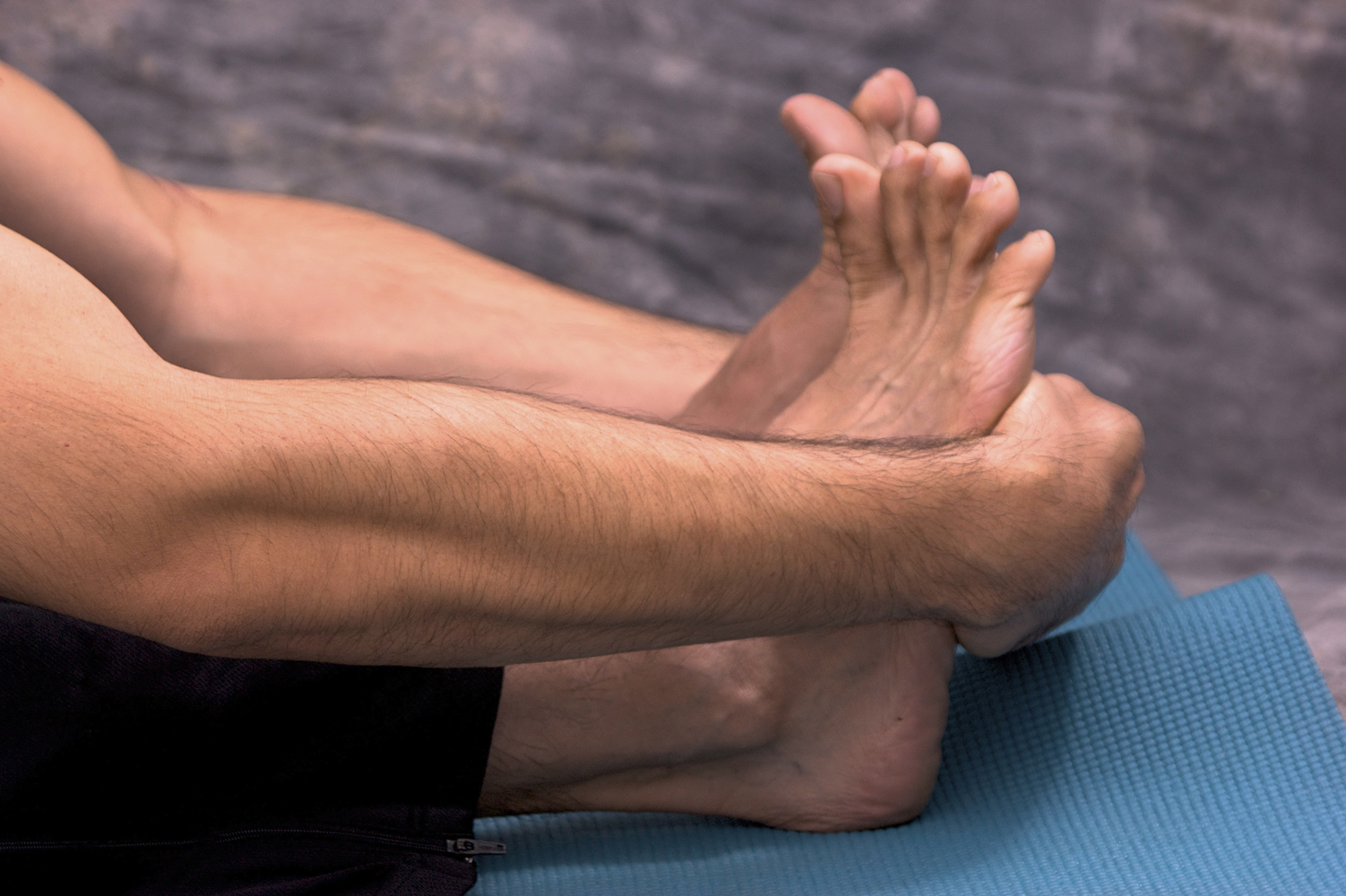
It is common for some individuals to wake up in the morning with some degree of foot pain. This can be significantly annoying for those who experience morning foot pain or soreness. There are several things that an individual might consider to address morning foot pain. For example, they might perform certain foot stretches to combat this pain. By performing certain gentle stretches in the morning, a patient may be able to potentially alleviate soreness, aches, and even moderate foot pain. These stretches can target different parts of the foot, such as the ankle, heel, arch, and toes. If you are someone that is prone to developing foot pain in the morning time, then it is suggested that you schedule an appointment with a podiatrist to address these issues.
Stretching the feet is a great way to prevent injuries. If you have any concerns with your feet consult with Howard Waxman, DPM from Pleasant Valley Podiatry. Our doctor will assess your condition and provide you with quality foot and ankle treatment.
Stretching the Feet
Being the backbone of the body, the feet carry your entire weight and can easily become overexerted, causing cramps and pain. As with any body part, stretching your feet can serve many benefits. From increasing flexibility to even providing some pain relief, be sure to give your feet a stretch from time to time. This is especially important for athletes or anyone performing aerobic exercises, but anyone experiencing foot pain or is on their feet constantly should also engage in this practice.
Great ways to stretch your feet:
Individuals who tend to their feet by regular stretching every day should be able to minimize foot pain and prevent new problems from arising.
If you have any questions, please feel free to contact one of our offices located in Willoughby Hills and Broadview Heights, OH . We offer the newest diagnostic and treatment technologies for all your foot care needs.
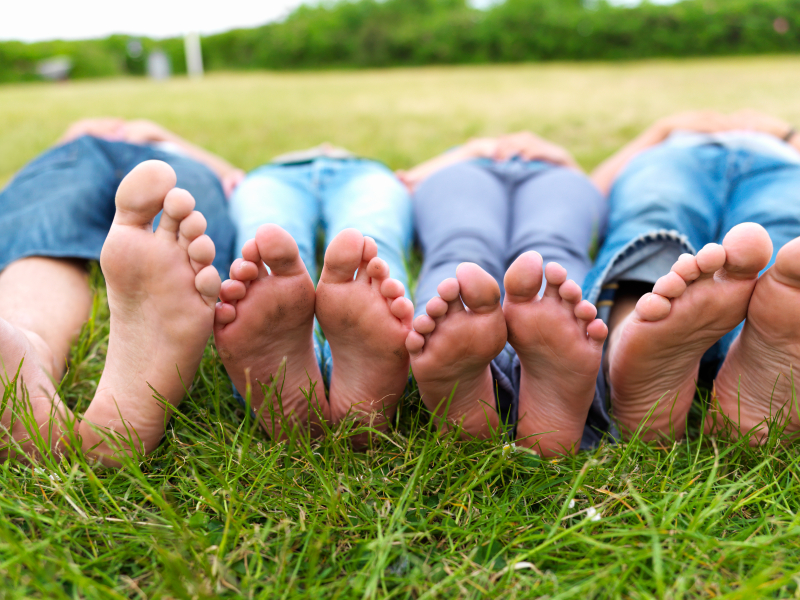
Kohler’s disease is a rare bone disorder that occurs among children between the ages of 3 and 7. It is the result of stress-related compression during certain growth periods. This condition may first be recognized by pain, swelling, redness, and limping. It is five times more likely to occur in male children and usually affects only one foot. The child’s foot will be especially tender along the arch because the flow of blood to one of the foot bones, the navicular, has been blocked. The reason for this is uncertain. The child may walk on the outside of his foot to reduce the pain. A visit to a podiatrist may include an X-ray of the affected foot, which will then be compared with that of the other foot. In addition to pain relievers, a podiatrist may prescribe a weight-bearing short cast or special supportive shoes for the child. In addition, staying off the affected foot can help to speed up recovery. In most cases, a child will outgrow the disorder in a few months as the bones resume their normal growth pattern, but in some cases, it can last as long as two years. If your child is exhibiting the symptoms of Kohler’s disease, it is suggested that you consult with a podiatrist.
Some foot conditions may require additional professional care. If you have any concerns, contact Howard Waxman, DPM of Pleasant Valley Podiatry. Our doctor can provide the care you need to keep you pain-free and on your feet.
Rare Foot Conditions
The majority of foot conditions are common and can be treated by a podiatrist. Standard diagnostic procedures are generally used to identify specific conditions and treatment can be rendered. A podiatrist also treats rare foot conditions which can be difficult to diagnose and may need extra attention and care.
There are many rare foot conditions that can affect children. Some of these can include:
Freiberg’s disease - This can be seen as a deterioration and flattening of a metatarsal bone that exists in the ball of the foot. It typically affects pre-teen and teenage girls, but can affect anyone at any age. Symptoms that can accompany this can be swelling, stiffness, and the patient may limp.
Kohler’s disease - This often targets the bone in the arch of the foot and affects younger boys. It can lead to an interruption of the blood supply which ultimately can lead to bone deterioration. The patient may limp or experience tenderness, swelling, and redness.
Maffucci syndrome - This affects the long bones in a child’s foot leading to the development of abnormal bone lesions. They are benign growths and typically develop in early childhood and the bones may be susceptible to breaking.
A podiatrist can properly diagnose and treat all types of rare foot conditions. If your child is affected by any of these symptoms or conditions, please don’t hesitate to call our office so the correct treatment method can begin.
If you have any questions please feel free to contact one of our offices located in Willoughby Hills and Broadview Heights, OH . We offer the newest diagnostic tools and technology to treat your foot and ankle needs.
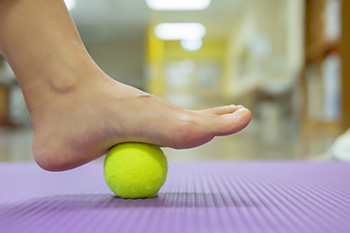
Exercising your feet regularly can improve your foot health and prevent injuries. Walking is the best form of exercise for the feet because it puts them through a full range of motion. Walking is also one of the best forms of exercise for the entire body in that it improves cardiovascular health, helps circulation, increases muscle tone, and enhances mood. Flexibility and resistance exercises can also help keep feet healthy. Flexibility or foot stretching exercises help keep feet limber. Resistance exercises are where one strengthens the muscles of the feet by working them against some form of resistance, such as weights or exercise bands. If you would like to learn more about exercises for your feet, it is suggested that you consult with a podiatrist, an expert in everything related to the feet and ankles.
Exercising your feet regularly with the proper foot wear is a great way to prevent injuries and build strength. If you have any concerns about your feet, contact Howard Waxman, DPM from Pleasant Valley Podiatry. Our doctor can provide the care you need to keep you pain-free and on your feet.
Exercise for Your Feet
Exercise for your feet can help you gain strength, mobility and flexibility in your feet. They say that strengthening your feet can be just as rewarding as strengthening another part of the body. Your feet are very important, and we often forget about them in our daily tasks. But it is because of our feet that are we able to get going and do what we need to. For those of us fortunate enough to not have any foot problems, it is an important gesture to take care of them to ensure good health in the long run.
Some foot health exercises can include ankle pumps, tip-toeing, toe rises, lifting off the floor doing reps and sets, and flexing the toes. It is best to speak with Our doctor to determine an appropriate regimen for your needs. Everyone’s needs and bodies are different, and the activities required to maintain strength in the feet vary from individual to individual.
Once you get into a routine of doing regular exercise, you may notice a difference in your feet and how strong they may become.
If you have any questions please feel free to contact one of our offices located in Willoughby Hills and Broadview Heights, OH . We offer the newest diagnostic and treatment technologies for all your foot and ankle needs.

It is perhaps true to say that we do not think about whether we use our legs in the same manner, or whether our feet feel the same way against the floor. It is likely that we assume everything on both sides of our body functions in the same way. However, most of us have one leg or foot that is stronger than the other. The stronger side often leads in performing specific tasks, including climbing stairs, jumping, or participating in sporting activities. Those who perform multiple activities are probably less likely to notice a dominant side as a result of frequently engaging both sides. Whether we have a dominant side or not can be immaterial, but it may become a problem to have a strength discrepancy on one side of the body, especially as we age. Simple exercises involving touch can help to reestablish a connection with our weaker, less dominant side. For example, practicing a basic step-up with one leg at a time will show us how it feels on each leg and foot. This can help us strengthen the non-dominant side by practicing the step-up more often with that side. Paying attention to the various ways we use our bodies can make it easier to stabilize the pattern that equalizes the feet and legs. This will help us balance and feel more comfortable using both sides of our bodies. If you are interested in learning about how your feet function and what you can do to strengthen your non-dominant side, it is suggested that you consult with a podiatrist.
If you have any concerns about your feet, contact Howard Waxman, DPM from Pleasant Valley Podiatry. Our doctor can provide the care you need to keep you pain-free and on your feet.
Biomechanics in Podiatry
Podiatric biomechanics is a particular sector of specialty podiatry with licensed practitioners who are trained to diagnose and treat conditions affecting the foot, ankle and lower leg. Biomechanics deals with the forces that act against the body, causing an interference with the biological structures. It focuses on the movement of the ankle, the foot and the forces that interact with them.
A History of Biomechanics
Modern technological improvements are based on past theories and therapeutic processes that provide a better understanding of podiatric concepts for biomechanics. Computers can provide accurate information about the forces and patterns of the feet and lower legs.
Understanding biomechanics of the feet can help improve and eliminate pain, stopping further stress to the foot.
If you have any questions please feel free to contact one of our offices located in Willoughby Hills and Broadview Heights, OH . We offer the newest diagnostic and treatment technologies for all your foot and ankle needs.

Gout is a type of arthritis most commonly affecting the big toe that can show itself as redness, tenderness, swelling in joints, and severe pain. Gout is caused by a buildup of uric acid in the body. Uric acid is a part of purines, an ingredient found in several foods. A process happens when uric acid crystals build up in joints. This condition can limit the range of movement, making it difficult to exercise or walk. Those most prone to gout include obese people, those with a genetic predisposition, and men. To help prevent gout, it is suggested to avoid alcohol, increase water intake, and reduce the consumption of sugary beverages, fish, and red meat. Gout is often diagnosed after an acute attack of symptoms, and a blood test can determine the levels of uric acid. A podiatrist can also perform other tests and provide treatment that will help relieve symptoms of gout. If you suffer from gout, it is a good idea to see a podiatrist today.
Gout is a foot condition that requires certain treatment and care. If you are seeking treatment, contact Howard Waxman, DPM from Pleasant Valley Podiatry. Our doctor will treat your foot and ankle needs.
What Is Gout?
Gout is a type of arthritis caused by a buildup of uric acid in the bloodstream. It often develops in the foot, especially the big toe area, although it can manifest in other parts of the body as well. Gout can make walking and standing very painful and is especially common in diabetics and the obese.
People typically get gout because of a poor diet. Genetic predisposition is also a factor. The children of parents who have had gout frequently have a chance of developing it themselves.
Gout can easily be identified by redness and inflammation of the big toe and the surrounding areas of the foot. Other symptoms include extreme fatigue, joint pain, and running high fevers. Sometimes corticosteroid drugs can be prescribed to treat gout, but the best way to combat this disease is to get more exercise and eat a better diet.
If you have any questions please feel free to contact one of our offices located in Willoughby Hills and Broadview Heights, OH . We offer the newest diagnostic and treatment technologies for all your foot and ankle needs.